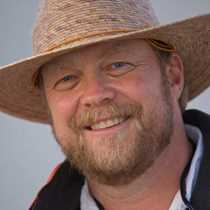Hornsund
It’s a bright, sunny morning as Captain Leif Skog inches the National Geographic Endeavour closer and closer to shore. Early risers take aim with their cameras as the polar bear walks slowly across the snowfield ahead of the ship. The bear gives scale to the grand landscape here in Hornsund, the southernmost fjord on the island of Spitsbergen. Tall, jagged peaks rise steeply above us from the rocky shore. Our Photo Expedition here in the far north is off to a great start!
After breakfast a series of safety briefings prepare us for the adventures that await us while exploring Svalbard. This Arctic archipelago lies between 76 and 80 degrees north, and 60 percent of the land mass is covered by glacial ice. Dressed and ready, we load into Zodiacs for a water-level view of the icebergs in Burgerbukta, a northern arm of Hornsund. Out on the water we cruise slowly among the blue icebergs floating like jewels illuminated from within. It’s a scene that few of us have experienced – or photographed – before.
As we enjoy a hot lunch the ship repositions to the west end of Hornsund where the Polish have a scientific research station. Our plans are to go ashore for a hike across the tundra behind the station to a seabird colony of little auks, or dovekeys. Tripods in hand, we split up into groups and make our way to the base of the rocky slope where these diminutive seabirds make their nests during the Arctic summer. Along the way we search for the perfect close-up photos of the miniature tundra wildflowers that carpet the spongy tundra underfoot. Coming up over a rise we are treated to a close view of several Svalbard reindeer grazing on the tundra. Clouds of birds fly by us as we approach the rocky talus slope. Two research biologists from Pomona College greet us and describe their work studying the life history of these diminutive seabirds. Over and over the dovekeys swarm from the rocks flying out toward the fjord, then circling back to land on the rocks. The speed of the birds whizzing by challenge our photographic skills. And the sound of their hilarious screams is something we will never forget. We leave the cliffs with the sights and sounds etched in our minds. On the way back to the ship we are invited inside the station. Many of us also explore the shoreline by kayak. It’s been a full afternoon.
Back on board we recount the events of the day in the Lounge during the Welcome Cocktail Party. Dinner follows as the ship leaves Hornsund and turns toward the South Cape of Spitsbergen. Our heads hit the pillows while the soothing motion of the ship rocks us gently to sleep.
It’s a bright, sunny morning as Captain Leif Skog inches the National Geographic Endeavour closer and closer to shore. Early risers take aim with their cameras as the polar bear walks slowly across the snowfield ahead of the ship. The bear gives scale to the grand landscape here in Hornsund, the southernmost fjord on the island of Spitsbergen. Tall, jagged peaks rise steeply above us from the rocky shore. Our Photo Expedition here in the far north is off to a great start!
After breakfast a series of safety briefings prepare us for the adventures that await us while exploring Svalbard. This Arctic archipelago lies between 76 and 80 degrees north, and 60 percent of the land mass is covered by glacial ice. Dressed and ready, we load into Zodiacs for a water-level view of the icebergs in Burgerbukta, a northern arm of Hornsund. Out on the water we cruise slowly among the blue icebergs floating like jewels illuminated from within. It’s a scene that few of us have experienced – or photographed – before.
As we enjoy a hot lunch the ship repositions to the west end of Hornsund where the Polish have a scientific research station. Our plans are to go ashore for a hike across the tundra behind the station to a seabird colony of little auks, or dovekeys. Tripods in hand, we split up into groups and make our way to the base of the rocky slope where these diminutive seabirds make their nests during the Arctic summer. Along the way we search for the perfect close-up photos of the miniature tundra wildflowers that carpet the spongy tundra underfoot. Coming up over a rise we are treated to a close view of several Svalbard reindeer grazing on the tundra. Clouds of birds fly by us as we approach the rocky talus slope. Two research biologists from Pomona College greet us and describe their work studying the life history of these diminutive seabirds. Over and over the dovekeys swarm from the rocks flying out toward the fjord, then circling back to land on the rocks. The speed of the birds whizzing by challenge our photographic skills. And the sound of their hilarious screams is something we will never forget. We leave the cliffs with the sights and sounds etched in our minds. On the way back to the ship we are invited inside the station. Many of us also explore the shoreline by kayak. It’s been a full afternoon.
Back on board we recount the events of the day in the Lounge during the Welcome Cocktail Party. Dinner follows as the ship leaves Hornsund and turns toward the South Cape of Spitsbergen. Our heads hit the pillows while the soothing motion of the ship rocks us gently to sleep.




